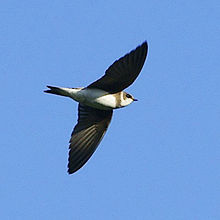Bank swallow
| Sand martin | |
|---|---|
 |
|
| Flying in Scotland | |
| Scientific classification | |
| Kingdom: | Animalia |
| Phylum: | Chordata |
| Class: | Aves |
| Order: | Passeriformes |
| Family: | Hirundinidae |
| Genus: | Riparia |
| Species: | R. riparia |
| Binomial name | |
|
Riparia riparia (Linnaeus, 1758) |
|
| Subspecies | |
|
|
| Synonyms | |
|
Hirundo riparia Linnaeus, 1758 |
|
Hirundo riparia Linnaeus, 1758
Riparia diluta (but see text)
The sand martin (Riparia riparia) or European sand martin, bank swallow in the Americas, and collared sand martin in the Indian Subcontinent, is a migratory passerine bird in the swallow family. It has a wide range in summer, embracing practically the whole of Europe and the Mediterranean countries, part of northern Asia and also North America. It winters in eastern and southern Africa, South America and the Indian Subcontinent.
This species was first described by Linnaeus in his Systema naturae in 1758, and originally named Hirundo riparia; the description consisted of the simple H[irundo] cinerea, gula abdomineque albis—"an ash-grey swallow, with white throat and belly"—and the type locality was simply given as "Europa". The specific name means "of the riverbank"; it is derived from the Latin ripa "riverbank".
The pale martin of northern India and southeastern China is now usually split as a separate species Riparia diluta. It has paler grey-brown upperparts and a less distinct breast band. It winters in Pakistan and southern India.
The 12 cm (4.7 in) long sand martin is brown above, white below with a narrow brown band on the breast; the bill is black, the legs brown. The young have rufous tips to the coverts and margins to the secondaries.
...
Wikipedia

